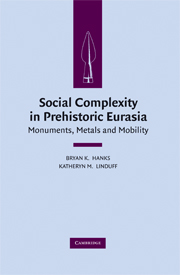Book contents
- Frontmatter
- Contents
- Contributors
- Foreword: From Myth to Method: Advances in the Archaeology of the Eurasian Steppe
- CHAPTER 1 Introduction: Reconsidering Steppe Social Complexity within World Prehistory
- PART ONE FRAMING COMPLEXITY
- PART TWO MINING, METALLURGY, AND TRADE
- CHAPTER 7 Introduction
- CHAPTER 8 Formation of the Eurasian Steppe Belt Cultures: Viewed through the Lens of Archaeometallurgy and Radiocarbon Dating
- CHAPTER 9 Late Prehistoric Mining, Metallurgy, and Social Organization in North Central Eurasia
- CHAPTER 10 The Bronze-Using Cultures in the Northern Frontier of Ancient China and the Metallurgies of Ancient Dian Area in Yunnan Province
- CHAPTER 11 Production and Social Complexity: Bronze Age Metalworking in the Middle Volga
- CHAPTER 12 Early Metallurgy and Socio-Cultural Complexity: Archaeological Discoveries in Northwest China
- PART THREE FRONTIERS AND BORDER DYNAMICS
- PART FOUR SOCIAL POWER, MONUMENTALITY, AND MOBILITY
- Index
CHAPTER 7 - Introduction
from PART TWO - MINING, METALLURGY, AND TRADE
Published online by Cambridge University Press: 26 January 2010
- Frontmatter
- Contents
- Contributors
- Foreword: From Myth to Method: Advances in the Archaeology of the Eurasian Steppe
- CHAPTER 1 Introduction: Reconsidering Steppe Social Complexity within World Prehistory
- PART ONE FRAMING COMPLEXITY
- PART TWO MINING, METALLURGY, AND TRADE
- CHAPTER 7 Introduction
- CHAPTER 8 Formation of the Eurasian Steppe Belt Cultures: Viewed through the Lens of Archaeometallurgy and Radiocarbon Dating
- CHAPTER 9 Late Prehistoric Mining, Metallurgy, and Social Organization in North Central Eurasia
- CHAPTER 10 The Bronze-Using Cultures in the Northern Frontier of Ancient China and the Metallurgies of Ancient Dian Area in Yunnan Province
- CHAPTER 11 Production and Social Complexity: Bronze Age Metalworking in the Middle Volga
- CHAPTER 12 Early Metallurgy and Socio-Cultural Complexity: Archaeological Discoveries in Northwest China
- PART THREE FRONTIERS AND BORDER DYNAMICS
- PART FOUR SOCIAL POWER, MONUMENTALITY, AND MOBILITY
- Index
Summary
The chapters in Part II focus on the importance of metal technology and its relationship to socio-political and economic change in the steppe zone and neighboring regions. The mining, production, and trade of bronze and other metals have been evaluated in the past through numerous analytical models, including core-periphery relationships, multiple-core developments, and the emergence of metallurgical provinces of interaction and exchange (Knauth 1974 ; Moorey 1985 ; Tylecote 1992 ; Chernykh 1992 ; Linduff 2004 ; Chernykh et al. 2004 ; Linduff et al. 2000, 2004). Such models have suggested the widespread and complex nature of early metallurgy in the steppe, and the following essays continue to refine and test our current understandings of the nature and extent of technological diffusion, the emergence of new social organization connected with mining and production communities, and interregional and intra-regional strategies connected with metals trade and exchange. Contributing authors were asked to discuss new ways of defining and investigating such social and technological developments in or with the steppe region. Important issues addressed within the chapters include defining the structure and organization of mining communities, theorizing elite strategies for political power foundations and their connection with trade and exchange patterns, the scale of interaction and diffusion of technology between steppe- and non-steppe-based polities, and the cycling dynamics of regional prominence associated with the rise and collapse of mining and production centers in the Eurasian region.
Perhaps most important, these chapters are based on newly available data that allow close examination of individual production centers and regions.
- Type
- Chapter
- Information
- Social Complexity in Prehistoric EurasiaMonuments, Metals and Mobility, pp. 107 - 114Publisher: Cambridge University PressPrint publication year: 2009

